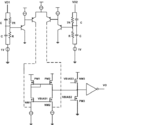xihuwang
Member level 2

A Bicoms receiver design in a RS-485 tranceiver IC
speed requeriment : 50M bps
simulation result : 70M bps
But test result show , the transfer delay is 35ns , which is bigger than the spec and simulation result.
Can any one help me to analysis the reason ?
One of my guess is the PNP ( lateral pnp) current gain is small ,(about 30) , and has big B input resistance.
Lateral pnp can't be used in signal path . But we have no choice because another type pnp is substrat pnp.
Another guess is , the dc operation point is not in best condition .
Can any one give me your analysis on this circuit.
VD1 & VD2 are the inputs. The commo-mode region is -7 ~ 12V. The power supply is 5V.
The resistor network is uesed to transfer the -7~12V common mode region to the common mode
region of the transconductance stage.
Last edited: